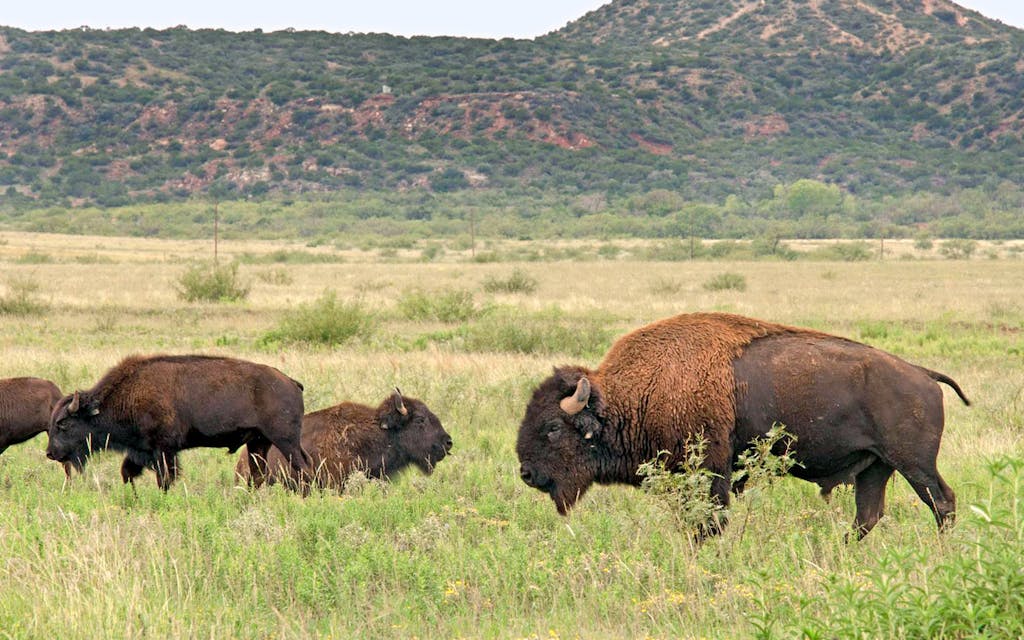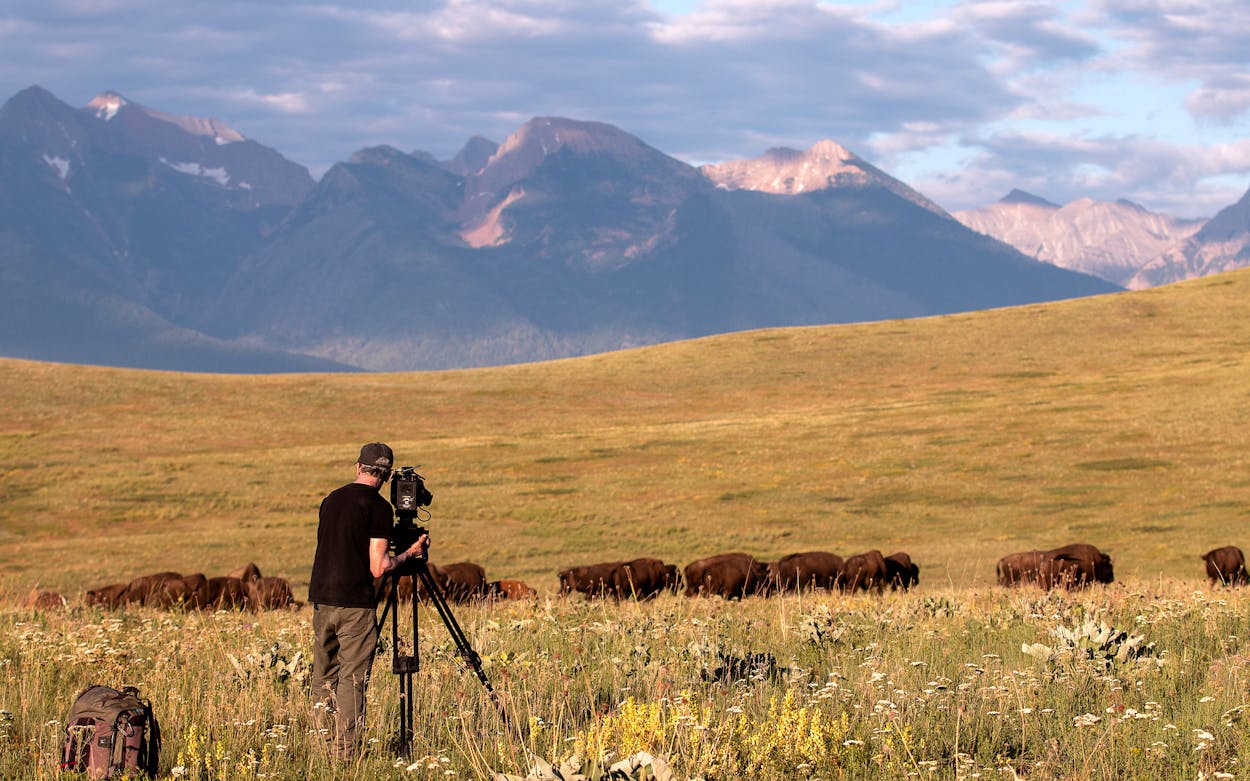This wasn’t the first time I doubted Ken Burns could make a subject interesting. The first time was when a friend urged me to watch the documentarian’s 1994 series Baseball. Though I took a mild, short-lived interest in the game after watching some of the series’ eighteen and a half hours, what kept me watching was the realization that Baseball isn’t really about baseball. No, what made the film engaging was the way it aligned the story of baseball with a grander story of the country: the changing relationship between labor and management; the cultural upheavals of the twentieth century; the struggle to dismantle our racial caste system. Don’t tug on Superman’s cape; don’t doubt Burns’s gift of committing great history to film.
I sometimes must learn the same lesson twice. Doubt crept over me when I heard of Burns’s latest subject. Four hours on the bison? What could possibly be said in four hours that can’t be said in one? But The American Buffalo, which will air in two parts on PBS starting October 16, is similar to Baseball in that the buffalo is the cynosure of the film, but not the true subject. We don’t learn that much about the buffalo itself: there’s little to nothing about its diet, migratory patterns, mating rituals, anatomy, or herd dynamics. This isn’t a nature documentary. Instead, the story of the buffalo—its commodification, desecration, eradication, and, only when it was at the brink of extinction, salvation—tells the story of what settling the West meant in practice. And Texas is where some of the story’s pivotal dramas played out. The result is one of Burns’s finest documentaries in his storied career.
The first European to see bison, Spanish explorer Álvar Núñez Cabeza de Vaca, stumbled on them in the early 1530s, in what is today Central Texas. He described the creatures as “hunch-backed cows.” What was a discovery for him had been the biggest fact of life on the North American continent for the past 10,000 years. The buffalo was the largest and most numerous species on the continent. At least 30 million of them—perhaps twice that, but in truth the number is unknowable—roamed as far south as roughly where Cabeza de Vaca saw them, as far north as the Arctic Circle, and from the Rockies to the Appalachians. For those thousands of years, humans lived alongside them. Actually, they lived because of them. Generation upon generation drew nourishment, clothing, tools, and shelter from the animal’s meat, skin, and bones. Little wonder then that the buffalo is central to Native American spirituality, in which man is not the central character and nature not his dominion.
But the Europeans who arrived on the continent after Cabeza de Vaca held an entirely different idea of what nature was for and where they stood in relation to it. As white settlers spread across the West in the eighteenth and nineteenth centuries, fulfilling what many believed was their manifest destiny, ten thousand years were undone in a matter of decades. By the early 1800s, there were no buffalo east of the Mississippi. By 1878, there were, to anyone’s knowledge, no buffalo south of the Arkansas River, in what is now Oklahoma. By 1886, the Smithsonian Institution in Washington, D.C., could not get a hold of a fresh bison skull or skin, so rare had they become. The last wild bison in Texas were spotted in 1889. By the following decade, only about 24 free-roaming bison were left in Yellowstone.
Such a targeted, swift, wholesale destruction of an animal species by humans had never been recorded and hasn’t been since, says historian Dan Flores in the film. The sheer productivity of the slaughter is staggering: the number of men who dedicated themselves exclusively to shooting bison, the miles they traveled, the number of bullets expended, the boomtowns built on their enterprise. Dodge City, Kansas, where at one point buffalo bones were used as legal tender, was the biggest and most famous of them. The Panhandle outpost of Adobe Walls, Texas, was also a rapidly expanding buffalo-hunting settlement, and the 1874 battle that took place there between the whites and allied Kiowas and Comanches, led by Quanah Parker, was what the latter hoped would be the start of a continental war destroying the industry.
What drove the whites’ enormous exertion? The buffalo was at the intersection of the two most significant developments in the United States: its transformation into an industrial nation and the settlement of the West. The bison was a source not just for mass commodities such as clothing, leather, and buttons, but also for factory parts, as its hide was particularly well suited for being made into machinery belting. Wild buffalo were also an obstacle in the way of settlement, since they competed for the same resources as settlers’ cattle. And, of course, they were the central natural resource for Native Americans. A dead buffalo was both a source of revenue for whites and one less buffalo for the tribes to use.
As the buffalo went, so went the Native American. This was keenly understood, and exploited, by white settlers and their government, which on their behalf negotiated with, and then often betrayed, Native Americans, and then murdered, or enabled the murder of, both them and their buffalo. Eradicating the buffalo was its own particularly cruel kind of murder because it eliminated a source of community and food—an estimated 10 percent of plains Native Americans died of malnutrition and disease in the winter of 1883–1884, when the mass slaughter of the buffalo reached its nauseating crescendo.
None of this, as several historians and Native Americans who are interviewed in documentary reiterate, was inevitable. It was intentional. The year after that devastating winter, Theodore Roosevelt, who would become president in 1901, published Hunting Trips of a Ranchman, in which he lamented the buffalo’s “needless and brutal” slaughter but in the same breath said, “[The buffalo’s] destruction was the condition precedent upon the advance of white civilization . . . Above all, the extermination of the buffalo was the only way of solving the Indian question . . . [the buffalo’s] disappearance was the only method of forcing them to at least partially abandon their savage mode of life. From the standpoint of humanity at large, the extermination of the buffalo has been a blessing.”
Those cruel words were deeply hypocritical coming from the “conservation president,” who is still lauded for his work expanding the national parks and investing heavily in public lands. But Roosevelt was merely stating what was plain as day to white settlers such as those erecting fences in Texas, including perhaps the most famous of them all, Charles Goodnight, whose story echoes that of many other prominent whites featured in the documentary. Goodnight was a settler and an Indian fighter, which by both counts meant he was also a buffalo exterminator. Establishing his cattle ranch in Palo Duro Canyon meant destroying the herds that roamed there so that his cattle could have exclusive access to the area’s water and grass. It also meant keeping the Comanche and Kiowa out: the fewer the buffalo, the fewer they would be.
But his wife, Molly, took pity on the bison and convinced her husband to gather some calves so she could raise them on their estate. Those calves became the progenitors of what is now known as the Goodnight herd, the last pure-blooded bison herd in North America. The Goodnights later donated some of the herd’s offspring to help conservation efforts across the country. (Today, you can see their descendants at Caprock Canyons State Park, home of Texas’s state bison herd.) This was also happening at the same time that Charles became a friend to his old foe, Quanah Parker, and, shortly after Parker’s death in 1911, hosted Kiowas on his ranch to make a film that included a scene of an authentic buffalo hunt performed by the tribesmen, one of very few captured on film from that era.

Charles Goodnight’s turn from exterminator to conservationist wasn’t unique. The most famous and productive bison killer, Charles “Buffalo” Jones, who alone likely massacred thousands of them, started raising his own herd in the Texas Panhandle, though even then his motives for doing so were mixed: out of penance for slaughtering them despite knowing the “cruelty” of the “murder” he committed, but also with an eye to establishing a business in cross-breeding the bison with domestic cattle (which failed). Roosevelt’s weak-kneed interest in conserving wildlife—primarily so that he and other “manly” Americans could continue hunting them—would strengthen thanks in part to his friendship with the conservationist George Bird Grinnell.
In the end, the only hope the American buffalo had for salvation was in the same people who had very nearly made them extinct, most of whom at one point or another had admitted that their actions reeked of cruelty and unconscionable excess. Today, according to the documentary, there are approximately 350,000 bison in the United States, 20,000 of which are protected in federal and state reserves, including about 150 at Caprock Canyons, but most of the rest are privately held and bred for slaughter. Saving the bison, to the extent it’s been saved, is the very least Americans could’ve done. The path to redemption starts in reflecting on questions the historian and Blackfeet tribe member Rosalyn LaPier asks in the film: Why are Americans so destructive? Why is this part of our history?
- More About:
- Texas History
- Film & TV
- Panhandle








